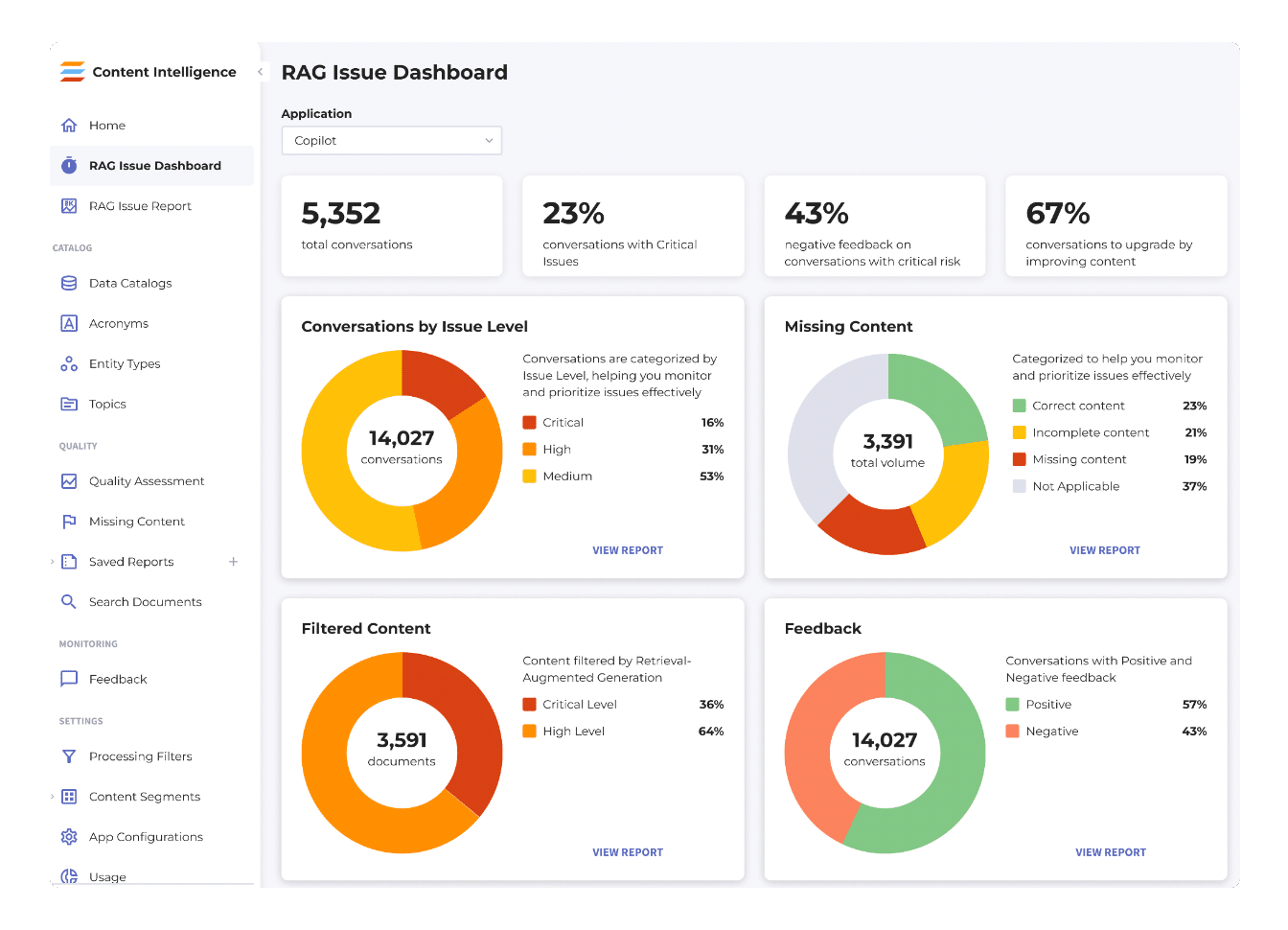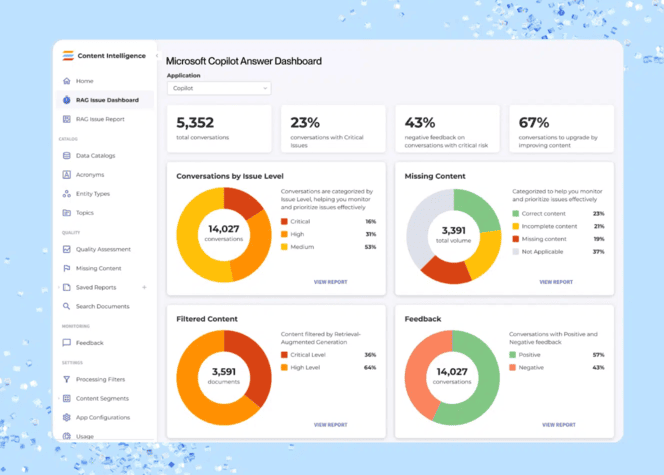Microsoft Copilot is a powerful AI assistant that helps you streamline tasks and boost your productivity. However, like all generative AI, it occasionally produces “hallucinations,” which are responses that sound confident but may be factually incorrect.
In fact, some studies suggest that hallucinations occur in 3% to 10% of all generative AI responses, depending on the model and task complexity. These inaccuracies can lead to misunderstandings, errors, user dissatisfaction, reputational risks, or even compliance issues that can harm your business, especially if you work in a high-stakes industry like finance, healthcare, or cyber security.
It’s important to understand the causes of hallucinations and follow practical strategies to prevent them. This is key to getting accurate and trustworthy results from Copilot.
What is Microsoft Copilot?
Microsoft Copilot is an AI-powered assistant integrated into Microsoft 365 applications like Word, Excel, and Outlook. It’s a powerful productivity tool that leverages large language models.
Copilot helps users draft documents, generate summaries, analyze data, create presentations, and more—all by interpreting natural language prompts.
The tool automates repetitive tasks, offers intelligent insights, and supports real-time collaboration, making advanced functionality accessible even to non-technical users.
However, like other generative AI, Copilot may sometimes produce hallucinations or inaccurate responses.
What are AI Hallucinations?
Artificial intelligence hallucinations happen when a language model like Microsoft Copilot generates responses that seem coherent but don’t align with reality. Instead of pulling from factual information or staying within its trained data, the AI produces content that might look accurate but contains incorrect, misleading, or entirely fabricated information.
These errors can be subtle, making it difficult to spot inaccuracies without fact-checking. Naturally, this is problematic because you don’t want to have to verify everything Copilot produces, otherwise it would make sense just to do the work yourself.
In general, hallucinations are a common issue with AI-generated content because they operate on probabilities, not grounded knowledge. While models like Copilot are trained to pull from vast datasets, they don’t truly “understand” the data in the human sense.
Instead, they rely on context and pattern-matching, which can lead to confident but incorrect responses—especially if they’re prompted on topics where training data is sparse or where responses require a nuanced understanding that AI can’t grasp.
Why Does Microsoft Copilot Create Hallucinations?
AI hallucinations stem from the way large language models like Microsoft Copilot process and generate text. Unlike a human, Copilot doesn’t access real-world knowledge or facts in real time. It simply produces answers based on probabilities drawn from patterns in its training data.
Here are several factors contribute to hallucinations in AI outputs:
- Gaps in Training Data: AI models are only as accurate as the data they’re trained on. If the training data lacks depth in a particular topic, Copilot might “fill in the blanks” with educated guesses rather than facts.
- Ambiguous or Complex Prompts: AI models rely on clear instructions. When prompts are vague or require nuanced knowledge, Copilot may generate plausible-sounding content that isn’t accurate, essentially inventing details to meet the prompt’s requirements.
- Limitations in Understanding Context: While Copilot can recognize patterns, it doesn’t “understand” language the way humans do. Copilot might misinterpret the prompt and generate irrelevant or incorrect information.
- Reaching Beyond Training Knowledge: AI models can hallucinate if prompted for information they weren’t explicitly trained on, especially for highly specialized or recent information. When pushed beyond its limits, Copilot may construct responses using related patterns. This can create results that sound correct but aren’t.
- Over-Reliance on Probabilistic Output: Copilot’s responses are based on probabilities rather than verifying the truthfulness of what it generates. When it encounters complex or ambiguous prompts, it might rely on a “best guess” approach, producing content that fits linguistic patterns but lacks factual grounding.
- Human-like Tone without Fact-checking: One of Copilot’s strengths is generating text that reads naturally and conversationally, which can also be a drawback. When this capability is combined with fabricated information, the response can seem trustworthy, even when it’s incorrect.
How to Prevent Microsoft Copilot Hallucinations
Microsoft Copilot can be a powerful tool, but like any AI, hallucinations can creep in. In order to get the most accurate results, we recommend following some key strategies to limit the number of hallucinations you experience.

1. Make Sure Your Data is High Quality
This is the most important piece of advice we give, but it bears repeating.
Copilot works best with high-quality data inputs. If you’re using specific data points or custom information, make sure it’s accurate and up-to-date before feeding it into Copilot’s responses. This way, Copilot can work off a solid foundation of correct information.
Example Prompt: “Based on the company’s current quarterly performance metrics [insert specific data], provide an overview of areas for improvement.”
2. Understand Copilot’s Data Limits
To prevent hallucinations, start by knowing where Copilot’s knowledge stops. It doesn’t pull in real-time information or have access to sources beyond its training data. Recognize that complex or niche topics beyond this scope may lead to inaccurate responses and avoid asking for recent events or highly specific data beyond Copilot’s training range.
Bad Prompt: “Summarize last night’s opinion piece in Project Manager News.”
Example Prompt: “Provide a summary of general best practices for project management.”
3. Include Data Sources
When possible, supply credible data sources in the prompt. Your job is to guide Copilot to draw from reliable information. This helps the AI stay aligned with factual, reputable data.
Example Prompt: “Using data from the World Health Organization, summarize key trends in global healthcare advancements over the last decade.”
This directs Copilot toward established knowledge areas rather than guesswork or from other sources that might publish less-reputable information.
4. Stick to the Copilot’s Expertise
AI models like Copilot excel in certain types of responses, like summarizing, rewriting, or providing general best practices. Avoid asking it for detailed legal, medical, or highly specialized advice unless it’s a general overview within its knowledge base.
Example Prompt: “Summarize common privacy considerations for website design.”
Avoid prompts like, “Explain the specific regulations in GDPR Article 20,” as Copilot may not handle such specificity accurately.
If you require specific information from Copilot, we strongly recommend verifying it before using it for a critical purpose.
5. Test Prompts for Consistency
Experiment with prompts to see if Copilot produces consistent and accurate responses. Slight wording changes can sometimes improve accuracy, so testing multiple variations can help you identify the most reliable prompt structure.
Example Prompt: “Summarize common challenges in remote team management.”
Try variations like “List typical obstacles remote managers face” and compare results to identify the most effective prompt.
6. Give Simple and Clear Prompts
Simple, clear prompts reduce ambiguity. Avoid overly complex or multi-part questions that can confuse the AI. Instead, use direct language and keep each prompt focused on one question or task. You’ll have more success and reduce hallucinations if you walk the AI down a path, rather than expecting it to provide everything you need all at once.
Example Prompt: “List three ways to improve team collaboration.”
Avoid: “How can team collaboration be improved, especially in remote settings, and what are some tools to use for it?”
It’s also smart to limit the range of possible answers Copilot can produce. Provide options or a specific structure so Copilot doesn’t have to improvise.
Example Prompt: “Provide a short summary of benefits for either time management or team collaboration—whichever you think is more relevant.” By narrowing down the response options, you reduce the likelihood of hallucinations.
7. Use Few-Shot Prompting
Few-shot prompting involves giving Copilot several examples to guide its response. This helps it understand the format or content you’re looking for. This is especially useful if you want Copilot to follow a specific style or structure.
Example Prompt: “Examples of project management best practices: Set clear goals, assign specific roles, and track progress regularly. List two more project management best practices.”
This kind of prompt provides Copilot with a clear structure and increases the chance it will deliver accurate responses in the format you need.
8. Provide Relevant Information
Supply only the most relevant information in your prompt to avoid overwhelming Copilot. Too much detail can dilute the main question. This can cause the AI to focus on less important aspects or become inconsistent in its responses.
Example Prompt: “Using last month’s sales data [provide data summary here], list key trends and suggest one area for improvement.”
This type of prompt limits the data to essential points so that Copilot focuses on the trends rather than unrelated details.
9. Limit Potential Mistakes
Identify areas where Copilot is likely to make errors, such as complex calculations, highly specific data interpretation, or subjective conclusions. Limit these in your prompts. Focus prompts on factual information or straightforward tasks.
Example Prompt: “Summarize common SEO practices.”
Avoid prompts like “List SEO techniques for our specific niche and analyze our current strategy,” as this may prompt Copilot to guess or invent details beyond its knowledge.
10. Assign a Role to You and Copilot
Establishing clear roles can make Copilot more accurate by giving it a context for its responses and limiting its scope. Give Copilot a role so it can speak from that point-of-view and assign yourself a role so Copilot formats its responses properly.
Example Prompt: “You are a cyber security expert and I am a freshman IT professional. Assist me in summarizing industry trends. Focus only on facts and avoid making recommendations.”
By defining Copilot’s role, you clarify its task, reducing chances of inaccurate advice or assumptions.
11. Tell Copilot What You Don’t Want
When you anticipate unwanted content or irrelevant details, be explicit about what Copilot should avoid. This helps Copilot stay on track and minimizes extraneous information or nonsensical responses.
Example Prompt: “Summarize the company’s current metrics, but avoid making projections or recommendations.” This guides Copilot to stick to the data provided and steer clear of assumptions.
12. Ask Copilot to Double-Check Itself
Encouraging Copilot to review its response can catch errors or add an extra layer of verification. When asking Copilot to double-check, it often refines its answer or provides a more measured response.
Example Prompt: “List potential legal considerations in AI implementation. Then, check for accuracy and correct any unclear or speculative points.” This prompts Copilot to take an additional pass, reducing inaccuracies.
13. Verify Important Topics
For critical or sensitive topics, always double-check Copilot’s output against reliable sources. This step is essential, as even minor inaccuracies can have significant implications depending on the context. Use Copilot as a starting point, but rely on human verification for final accuracy.
14. Monitor for Repeated Hallucinations
If Copilot frequently hallucinates on a particular topic or task, take note and adjust your prompts or expectations accordingly. Patterns in hallucinations may indicate where Copilot’s understanding is limited.
In these cases, refine or rephrase your prompts or supply more context to improve future AI-generated responses. Copilot can use this user feedback to offer a new response. If you can’t avoid hallucinations, you may be at the limit of Copilot’s capabilities and have to find the information manually.
Minimize Hallucations for Better Copilot Output
Preventing AI hallucinations is not just about improving the quality of AI outputs—it’s about protecting the integrity of decision-making and minimizing errors. In an age where AI is rapidly becoming integral to our operations, even a single hallucination can cascade into costly consequences, from compliance issues to reputational harm.
By proactively managing hallucinations, you can leverage AI as a dependable asset rather than a potential liability. Thoughtful implementation, regular validation, and understanding Copilot’s limitations are fundamental steps in ensuring that AI supports rather than undermines your objectives.




